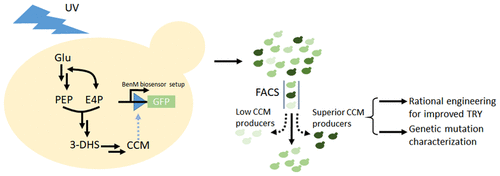当前位置:
X-MOL 学术
›
ACS Synth. Biol.
›
论文详情
Our official English website, www.x-mol.net, welcomes your
feedback! (Note: you will need to create a separate account there.)
Improvement of cis,cis-Muconic Acid Production in Saccharomyces cerevisiae through Biosensor-Aided Genome Engineering.
ACS Synthetic Biology ( IF 3.7 ) Pub Date : 2020-02-14 , DOI: 10.1021/acssynbio.9b00477 Guokun Wang 1 , Süleyman Øzmerih 1 , Rogério Guerreiro 2 , Ana C Meireles 2 , Ana Carolas 2 , Nicholas Milne 1 , Michael K Jensen 1 , Bruno S Ferreira 2 , Irina Borodina 1
ACS Synthetic Biology ( IF 3.7 ) Pub Date : 2020-02-14 , DOI: 10.1021/acssynbio.9b00477 Guokun Wang 1 , Süleyman Øzmerih 1 , Rogério Guerreiro 2 , Ana C Meireles 2 , Ana Carolas 2 , Nicholas Milne 1 , Michael K Jensen 1 , Bruno S Ferreira 2 , Irina Borodina 1
Affiliation

|
Muconic acid is a potential platform chemical for the production of nylon, polyurethanes, and terephthalic acid. It is also an attractive functional copolymer in plastics due to its two double bonds. At this time, no economically viable process for the production of muconic acid exists. To harness novel genetic targets for improved production of cis,cis-muconic acid (CCM) in the yeast Saccharomyces cerevisiae, we employed a CCM-biosensor coupled to GFP expression with a broad dynamic response to screen UV-mutagenesis libraries of CCM-producing yeast. Via fluorescence activated cell sorting we identified a clone Mut131 with a 49.7% higher CCM titer and 164% higher titer of biosynthetic intermediate-protocatechuic acid (PCA). Genome resequencing of the Mut131 and reverse engineering identified seven causal missense mutations of the native genes (PWP2, EST2, ATG1, DIT1, CDC15, CTS2, and MNE1) and a duplication of two CCM biosynthetic genes, encoding dehydroshikimate dehydratase and catechol 1,2-dioxygenase, which were not recognized as flux controlling before. The Mut131 strain was further rationally engineered by overexpression of the genes encoding for PCA decarboxylase and AROM protein without shikimate dehydrogenase domain (Aro1pΔE), and by restoring URA3 prototrophy. The resulting engineered strain produced 20.8 g/L CCM in controlled fed-batch fermentation, with a yield of 66.2 mg/g glucose and a productivity of 139 mg/L/h, representing the highest reported performance metrics in a yeast for de novo CCM production to date and the highest production of an aromatic compound in yeast. The study illustrates the benefit of biosensor-based selection and brings closer the prospect of biobased muconic acid.
中文翻译:

通过生物传感器辅助基因组工程改进酿酒酵母中顺式、顺式-粘康酸的产生。
粘康酸是生产尼龙、聚氨酯和对苯二甲酸的潜在平台化学品。由于它的两个双键,它也是塑料中一种有吸引力的功能共聚物。目前,不存在经济可行的粘康酸生产方法。为了利用新的遗传靶点来提高酵母酿酒酵母中顺式、顺式粘康酸 (CCM) 的产量,我们采用了 CCM 生物传感器与 GFP 表达耦合,具有广泛的动态响应来筛选产生 CCM 的酵母的 UV 诱变文库. 通过荧光激活细胞分选,我们鉴定了一个克隆 Mut131,其 CCM 滴度高 49.7%,生物合成中间原儿茶酸 (PCA) 滴度高 164%。Mut131 的基因组重测序和逆向工程确定了天然基因(PWP2、EST2、ATG1、DIT1、CDC15、CTS2 和 MNE1)的七个因果错义突变和两个 CCM 生物合成基因的重复,编码脱氢莽草酸脱水酶和儿茶酚 1,2 -双加氧酶,以前不被认为是通量控制。通过过表达无莽草酸脱氢酶结构域 (Aro1pΔE) 的 PCA 脱羧酶和 AROM 蛋白的编码基因,并通过恢复 URA3 原养型,进一步合理改造 Mut131 菌株。所得工程菌株在受控补料分批发酵中产生 20.8 g/L CCM,葡萄糖产量为 66.2 mg/g,生产率为 139 mg/L/h,代表迄今为止报告的酵母从头 CCM 生产的最高性能指标和酵母中芳香化合物的最高产量。该研究说明了基于生物传感器的选择的好处,并使生物基粘康酸的前景更加接近。
更新日期:2020-02-17
中文翻译:

通过生物传感器辅助基因组工程改进酿酒酵母中顺式、顺式-粘康酸的产生。
粘康酸是生产尼龙、聚氨酯和对苯二甲酸的潜在平台化学品。由于它的两个双键,它也是塑料中一种有吸引力的功能共聚物。目前,不存在经济可行的粘康酸生产方法。为了利用新的遗传靶点来提高酵母酿酒酵母中顺式、顺式粘康酸 (CCM) 的产量,我们采用了 CCM 生物传感器与 GFP 表达耦合,具有广泛的动态响应来筛选产生 CCM 的酵母的 UV 诱变文库. 通过荧光激活细胞分选,我们鉴定了一个克隆 Mut131,其 CCM 滴度高 49.7%,生物合成中间原儿茶酸 (PCA) 滴度高 164%。Mut131 的基因组重测序和逆向工程确定了天然基因(PWP2、EST2、ATG1、DIT1、CDC15、CTS2 和 MNE1)的七个因果错义突变和两个 CCM 生物合成基因的重复,编码脱氢莽草酸脱水酶和儿茶酚 1,2 -双加氧酶,以前不被认为是通量控制。通过过表达无莽草酸脱氢酶结构域 (Aro1pΔE) 的 PCA 脱羧酶和 AROM 蛋白的编码基因,并通过恢复 URA3 原养型,进一步合理改造 Mut131 菌株。所得工程菌株在受控补料分批发酵中产生 20.8 g/L CCM,葡萄糖产量为 66.2 mg/g,生产率为 139 mg/L/h,代表迄今为止报告的酵母从头 CCM 生产的最高性能指标和酵母中芳香化合物的最高产量。该研究说明了基于生物传感器的选择的好处,并使生物基粘康酸的前景更加接近。











































 京公网安备 11010802027423号
京公网安备 11010802027423号